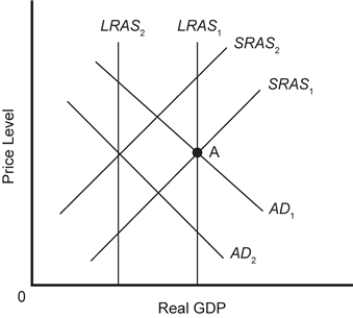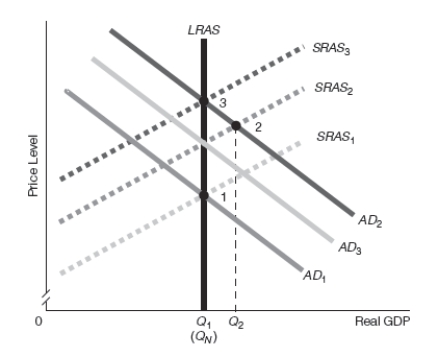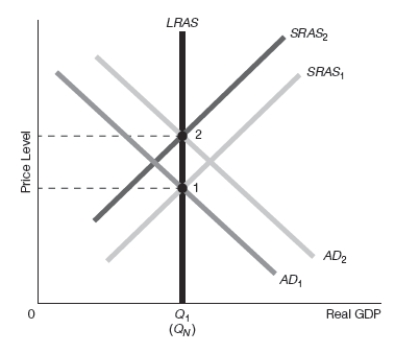A) there is an inverse relationship between the wage inflation rate and unemployment.
B) there is a direct relationship between the wage inflation rate and unemployment.
C) there is an inverse relationship between price inflation and unemployment.
D) there is a direct relationship between price inflation and unemployment.
E) a and b
Correct Answer

verified
Correct Answer
verified
True/False
Expectations theory tells us that what people think can impact the economy.
Correct Answer

verified
Correct Answer
verified
Multiple Choice
Suppose that the Fed expects to increase the money supply by $49 billion,but economic agents expect that the increase will be closer to $75 billion.Using rational expectations theory,the result will be ______________ Real GDP and a ________________ price level.
A) lower;higher
B) lower;lower
C) higher;higher
D) higher;lower
Correct Answer

verified
Correct Answer
verified
Multiple Choice
Exhibit 16-4  -Refer to Exhibit 16-4.The economy is initially at point A,in long run equilibrium.A real business cycle would be represented by the following sequence of curve shifts:
-Refer to Exhibit 16-4.The economy is initially at point A,in long run equilibrium.A real business cycle would be represented by the following sequence of curve shifts:
A) SRAS1 to SRAS2,then LRAS1 to LRAS2.
B) AD1 to AD2,then LRAS1 to LRAS2.
C) LRAS1 to LRAS2,then AD1 to AD2.
D) LRAS1 to LRAS2,then SRAS1 to SRAS2.
E) none of the above
Correct Answer

verified
Correct Answer
verified
Multiple Choice
If expectations are formed rationally,wages and prices are not completely flexible in the short run,and policy is correctly anticipated,increases in aggregate demand will stimulate the economy to higher levels of Real GDP and lower levels of unemployment in
A) the short run or the long run.
B) neither the short run nor the long run.
C) the short run,but not in the long run.
D) the long run,but in not the short run.
Correct Answer

verified
Correct Answer
verified
Multiple Choice
Stagflation implies that
A) a tradeoff between inflation and unemployment may not always exist.
B) policymakers can choose to have less unemployment if they are willing to accept a higher rate of inflation.
C) the short-run Phillips curve is stable.
D) the short-run Phillips curve is vertical.
Correct Answer

verified
Correct Answer
verified
Multiple Choice
Exhibit 16-8  -Refer to Exhibit 16-8.Assume that the starting point is point 1.Suppose that the Fed implements expansionary monetary policy that raises aggregate demand.Which of the following best goes with the diagram shown?
-Refer to Exhibit 16-8.Assume that the starting point is point 1.Suppose that the Fed implements expansionary monetary policy that raises aggregate demand.Which of the following best goes with the diagram shown?
A) New classical theory with policy incorrectly anticipated,bias downward
B) New classical theory with policy incorrectly anticipated,bias upward
C) Real business cycle theory
D) New classical theory with policy unanticipated
E) Policy ineffectiveness proposition (PIP)
Correct Answer

verified
Correct Answer
verified
Multiple Choice
For the period 1961 to 1969,the Phillips curve for the United States displayed the same shape that A.W.Phillips found for the United Kingdom for the period 1861 to 1913---it was
A) horizontal.
B) vertical.
C) downward sloping.
D) upward sloping.
Correct Answer

verified
Correct Answer
verified
Multiple Choice
Exhibit 16-10  -Refer to Exhibit 16-10.Assume that the starting point is point 1.Suppose that the government implements expansionary fiscal policy that raises aggregate demand.Which of the following best goes with the diagram shown?
-Refer to Exhibit 16-10.Assume that the starting point is point 1.Suppose that the government implements expansionary fiscal policy that raises aggregate demand.Which of the following best goes with the diagram shown?
A) New classical theory with policy incorrectly anticipated,bias downward
B) New classical theory with policy incorrectly anticipated,bias upward
C) Real business cycle theory
D) New classical theory with policy unanticipated
E) Policy ineffectiveness proposition (PIP)
Correct Answer

verified
Correct Answer
verified
Multiple Choice
Exhibit 16-4  -The economy is initially in long-run equilibrium.Expectations are adaptive,prices and wages are flexible,and there is an unanticipated increase in aggregate demand.In the short run,the price level will be __________ than it was in long-run equilibrium and Real GDP will be __________ than it was in long-run equilibrium.
-The economy is initially in long-run equilibrium.Expectations are adaptive,prices and wages are flexible,and there is an unanticipated increase in aggregate demand.In the short run,the price level will be __________ than it was in long-run equilibrium and Real GDP will be __________ than it was in long-run equilibrium.
A) higher;lower
B) lower;higher
C) lower;lower
D) higher;higher
Correct Answer

verified
Correct Answer
verified
Multiple Choice
New classical economists believe that if policy is correctly anticipated and if rational expectations hold,when the Fed increases the money supply the result will be a(n) ______________ in the price level and ____________________________.
A) decrease;no change in Real GDP
B) decrease;decrease in Real GDP
C) increase;no change in Real GDP
D) increase;increase in Real GDP
Correct Answer

verified
Correct Answer
verified
Multiple Choice
Real business cycle theory would emphasize the ability of a beneficial supply shock to shift the __________ curve rightward and __________ Real GDP.
A) AD;lower
B) AD;raise
C) LRAS;lower
D) LRAS;raise
Correct Answer

verified
Correct Answer
verified
Multiple Choice
Suppose that the Fed implements expansionary monetary policy that raises aggregate demand,but individuals incorrectly anticipate the policy measure (bias downward) .According to new classical theory,in the short run the price level would ____________ and Real GDP would ______________.In the long run,new classical theory would predict that the price level would ___________compared to its original long-run equilibrium level and that Real GDP would ____________.
A) rise;decline;rise;remain unchanged
B) rise;rise;rise;remain unchanged
C) rise;decline;remain unchanged;rise
D) fall;rise;remain unchanged;rise
Correct Answer

verified
Correct Answer
verified
Multiple Choice
The original Phillips curve suggests a(n) __________ relationship between the rate of change in __________ and the __________.
A) direct;prices;unemployment rate
B) inverse;money wage rates;unemployment rate
C) inverse;prices;unemployment
D) direct;money wage rates;money supply
E) inverse;money wage rates;money supply
Correct Answer

verified
Correct Answer
verified
Multiple Choice
Starting from long-run equilibrium,if the public anticipates that policymakers will increase aggregate demand by less than policymakers do increase aggregate demand,and if the short-run aggregate supply curve fully adjusts to the (incorrectly) anticipated increase in aggregate demand,then Real GDP will __________ and the price level will __________.
A) rise;rise
B) decline;fall
C) stay constant;rise
D) decline;rise
Correct Answer

verified
Correct Answer
verified
Multiple Choice
The economy was in long-run equilibrium when aggregate demand increased.At this point in time,the expected inflation has started to adjust to the new higher actual inflation rate.According to the (Friedman) natural rate theory,this means the unemployment rate in the economy must currently be
A) decreasing.
B) increasing.
C) higher than it was in long-run equilibrium.
D) equal to what it was in long-run equilibrium.
E) There is not enough information to answer the question.
Correct Answer

verified
Correct Answer
verified
Multiple Choice
According to real business cycle theorists,if the long-run aggregate supply (LRAS) curve shifts to the left,Real GDP __________,the price level __________,the demand for labor __________,money wages __________,real wages __________,and workers choose to work __________.
A) falls;falls;rises;fall;fall;less
B) falls;rises;rises;fall;rise;more
C) falls;rises;falls;fall;fall;less
D) rises;rises;falls;fall;rise;more
E) rises;falls;rises;fall;fall;more
Correct Answer

verified
Correct Answer
verified
Multiple Choice
New Keynesian theorists argue that
A) price and wage adjustments in response to policy changes often overcompensate and cause further price disruptions.
B) prices and wages may not be free to adjust in response to policy changes.
C) unions and big business have considerable power and often choose not to change wages and prices so as to deliberately offset policy changes enacted by the government.
D) the Fed and the Congress rarely do what they say they will do,so one should never listen to what they say.
E) new classical rational expectations theories about how expectations are formed are completely wrong.
Correct Answer

verified
Correct Answer
verified
Multiple Choice
In the 1970s and early 1980s,the U.S.economy experienced
A) stagflation.
B) low inflation and low unemployment.
C) high inflation and low unemployment.
D) high inflation and high unemployment.
E) a and d
Correct Answer

verified
Correct Answer
verified
True/False
Rational expectations theory is also known as the Friedman fooling theory.
Correct Answer

verified
Correct Answer
verified
Showing 41 - 60 of 132
Related Exams